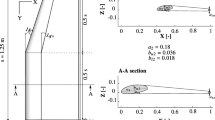Abstract
Infinitely thin wings weakly perturbing a supersonic flow of perfect gas are investigated. The flow problem is solved in a linear formulation [1]. The shape of the wing in plan and the Mach number M∞ of the oncoming flow are specified. The optimal wing surface is determined as a result of finding the function of the local angles of attack αM(x, z) which ensures a minimum of the drag coefficient cx when there are limitations in the form of equalities on the lift coefficient cy and the pitching moment mz. A separationless flow regime is realized on the optimal wing for the given number M∞, and its subsonic leading edge does not experience a load [2].
Similar content being viewed by others
Literature cited
E. A. Xrasil'shchikova, A Thin Wing in a Compressible Flow [in Russian], Nauka, Moscow (1978).
V. N. Zhigulev, “Thin minimum drag wings,” in: Aeromechanics [in Russian], Nauka, Moscow (1976), pp. 24–31.
I. P. Logunov and G. L. Yakimov, “Calculated investigations of the drag of nonplane wings at supersonic velocities depending on the shape of their middle surfaces,” Tr. TsAGI, No. 1198, 3 (1970).
Ya. S. Shcherbak and L. A. Kosyachenko, “Theoretical shapes of the middle surface of a nonplane wing of a supersonic passenger aircraft,” Tr. Vyssh. Aviats. Uchilishcha Grazhd. Aviatsii, No. 41, 5 (1970).
N. P. Korobeinikov, “Optimal nonplane wings in a supersonic flow,” in: Chaplygin Lectures [in Russian], Sb. Dokl. TsITI Volna (1983), pp. 34–83.
E. M. Prokhorov, “Isoperimetric optimization of the surface of wings of simple shape in plan with allowance for thickness,” in: Problems of Aerodynamics of Bodies of Spatial Configuration [in Russian], Novosibirsk (1982), pp. 104–119.
Ya. S. Shcherbak and Yu. V. Adamenko, “Physical restrictions of linear theory in problems of the optimization of the aerodynamic characteristics of nonplane wings,” Tr. Vyssh. Aviats. Uchilishcha Grazhd. Aviatsii, No. 37, 4 (1969)
Yu, G. Bokovikov, “Calculation of the aerodynamic characteristics of complicated geometry wings in a supersonic flow,” Izv. Sib. Otd. Akad. Nauk SSSR, Ser. Tekh. Nauk, No. 2, 48 (1974).
I. V. Kurdyumov, M. V. Mosolova, and V. E. Nazaikinskii, “Computational algorithm for the problem of large-dimension quadratic programming,” Zh. Vychisl. Mat. Mat. Fiz.,18, 1119 (1978).
N. N. Glushkov, D. P. Krotkov, and L. M. Shkadov, “Variation of the aerodynamic shape of a body leading to the reduction of its drag,” Uch. Zap. TsAGI,3, 11 (1972).
A. P. Shashkin, “Complex of programs for the graphical interpretation of the results of a calculation,” Preprint No. 27 [in Russian], Institute of Theoretical and Applied Mechanics, Novosibirsk (1982).
R. M. Kulfan and A. Sigalla, “Real flow limitations in supersonic design,” J. Aircr.,16, 645 (1979).
Author information
Authors and Affiliations
Additional information
Translated from Izvestiya Akademii Nauk SSSR, Mekhanika Zhidkosti i Gaza, No. 6, pp. 154–160, November–December, 1985.
Rights and permissions
About this article
Cite this article
Prokhorov, E.M. Optimal lifting surfaces of complicated-geometry wings at supersonic flight velocities. Fluid Dyn 20, 964–969 (1985). https://doi.org/10.1007/BF01049944
Received:
Issue Date:
DOI: https://doi.org/10.1007/BF01049944



